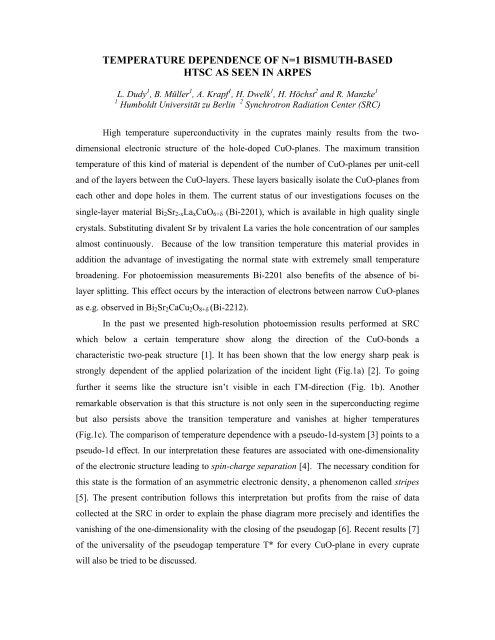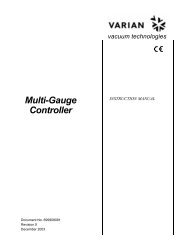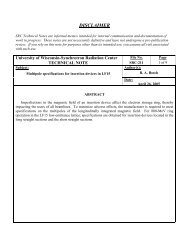SRC Users' Meeting - Synchrotron Radiation Center - University of ...
SRC Users' Meeting - Synchrotron Radiation Center - University of ...
SRC Users' Meeting - Synchrotron Radiation Center - University of ...
Create successful ePaper yourself
Turn your PDF publications into a flip-book with our unique Google optimized e-Paper software.
TEMPERATURE DEPENDENCE OF N=1 BISMUTH-BASED<br />
HTSC AS SEEN IN ARPES<br />
L. Dudy 1 , B. Müller 1 , A. Krapf 1 , H. Dwelk 1 , H. Höchst 2 and R. Manzke 1<br />
1 Humboldt Universität zu Berlin 2 <strong>Synchrotron</strong> <strong>Radiation</strong> <strong>Center</strong> (<strong>SRC</strong>)<br />
High temperature superconductivity in the cuprates mainly results from the twodimensional<br />
electronic structure <strong>of</strong> the hole-doped CuO-planes. The maximum transition<br />
temperature <strong>of</strong> this kind <strong>of</strong> material is dependent <strong>of</strong> the number <strong>of</strong> CuO-planes per unit-cell<br />
and <strong>of</strong> the layers between the CuO-layers. These layers basically isolate the CuO-planes from<br />
each other and dope holes in them. The current status <strong>of</strong> our investigations focuses on the<br />
single-layer material Bi 2 Sr 2-x La x CuO 6+ (Bi-2201), which is available in high quality single<br />
crystals. Substituting divalent Sr by trivalent La varies the hole concentration <strong>of</strong> our samples<br />
almost continuously. Because <strong>of</strong> the low transition temperature this material provides in<br />
addition the advantage <strong>of</strong> investigating the normal state with extremely small temperature<br />
broadening. For photoemission measurements Bi-2201 also benefits <strong>of</strong> the absence <strong>of</strong> bilayer<br />
splitting. This effect occurs by the interaction <strong>of</strong> electrons between narrow CuO-planes<br />
as e.g. observed in Bi 2 Sr 2 CaCu 2 O 8+ (Bi-2212).<br />
In the past we presented high-resolution photoemission results performed at <strong>SRC</strong><br />
which below a certain temperature show along the direction <strong>of</strong> the CuO-bonds a<br />
characteristic two-peak structure [1]. It has been shown that the low energy sharp peak is<br />
strongly dependent <strong>of</strong> the applied polarization <strong>of</strong> the incident light (Fig.1a) [2]. To going<br />
further it seems like the structure isn’t visible in each M-direction (Fig. 1b). Another<br />
remarkable observation is that this structure is not only seen in the superconducting regime<br />
but also persists above the transition temperature and vanishes at higher temperatures<br />
(Fig.1c). The comparison <strong>of</strong> temperature dependence with a pseudo-1d-system [3] points to a<br />
pseudo-1d effect. In our interpretation these features are associated with one-dimensionality<br />
<strong>of</strong> the electronic structure leading to spin-charge separation [4]. The necessary condition for<br />
this state is the formation <strong>of</strong> an asymmetric electronic density, a phenomenon called stripes<br />
[5]. The present contribution follows this interpretation but pr<strong>of</strong>its from the raise <strong>of</strong> data<br />
collected at the <strong>SRC</strong> in order to explain the phase diagram more precisely and identifies the<br />
vanishing <strong>of</strong> the one-dimensionality with the closing <strong>of</strong> the pseudogap [6]. Recent results [7]<br />
<strong>of</strong> the universality <strong>of</strong> the pseudogap temperature T* for every CuO-plane in every cuprate<br />
will also be tried to be discussed.
















